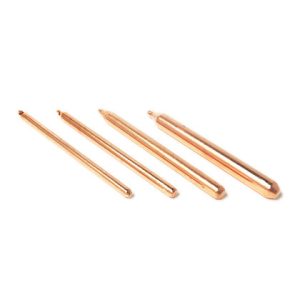What Are Heat Pipes?
A heat pipe is a highly efficient passive heat transfer device that utilizes phase change principles to transfer thermal energy from a heat source to a heat sink. It consists of a sealed, hollow tube with an inner wick structure and a working fluid. The primary mechanism that drives heat transfer in a heat pipe is the phase change of the working fluid from liquid to vapour and back.
This process dissipates heat by transporting thermal energy through capillary action from a heat source to a heat sink for cooling purposes.
The heat pipe operates on the principles of evaporation and condensation. When the heat source heats the heat pipe’s evaporator section, the working fluid absorbs heat until it vaporises. This vapour migrates to the condenser section, condenses back into liquid, and releases heat. The condensed liquid then returns to the evaporator through capillary action facilitated by the wick structure.
Benefits
Heat pipes offer a range of benefits for thermal management including high levels of thermal conductivity, including efficient heat transfer over long distances. They are passive devices that do not require any external power to operate. This makes them reliable, maintenance-free, and suitable for a number of different environments.
A heat pipe can help maintain uniform temperature distribution across a surface by effectively spreading heat from hot spots to cooler areas. They can also provide thermal isolation between the heat source and the heat sink, preventing potential heat damage of other components as well as being compact and lightweight, making them suitable for applications with limited space.
Usage
Heat pipes are used in a wide range of applications, including electronic components such as CPUs, GPUs, and power amplifiers. They efficiently transfer heat away from the components, preventing overheating. Heat pipes are used in LED lighting systems to dissipate the heat generated by high-intensity LEDs, ensuring their longevity and maintaining optimal performance. Heat pipes play a vital role in aerospace applications like avionics cooling and engine thermal management. They are also found in medical equipment such as laser systems and MRI machines to manage heat generated during operation, ensuring patient safety and device performance.
Heat pipes are often more cost effective than vapour chambers, however for some applications multiple pipes may be required to achieve effective cooling which may restrict design and increase cost.
Summary
In conclusion, heat pipes are versatile thermal management devices that offer efficient, passive, and reliable heat transfer solutions for a wide range of applications across various industries. Their ability to transport heat over long distances while maintaining uniform temperature distribution makes them indispensable in modern thermal engineering.
Features:
- Excellent thermal conductivity
- Passive component with high stability (reliable)
- Very low thermal resistance
- Uniform temperature distribution
Applications:
- Best for high power applications
- Electronic components: IC, CPU, MOS, LED, Motherboard, Power Supply, Heat Sink,
- LED TV, Notebook, PC, Telecom Device, Wireless Hub, etc.
- DDR II Module, Hand-set applications, etc.
Find Out More:
- T-Global Technology are experts in thermal management solutions, offering a wide range of off-the-shelf or customised products tailored to your requirements.


